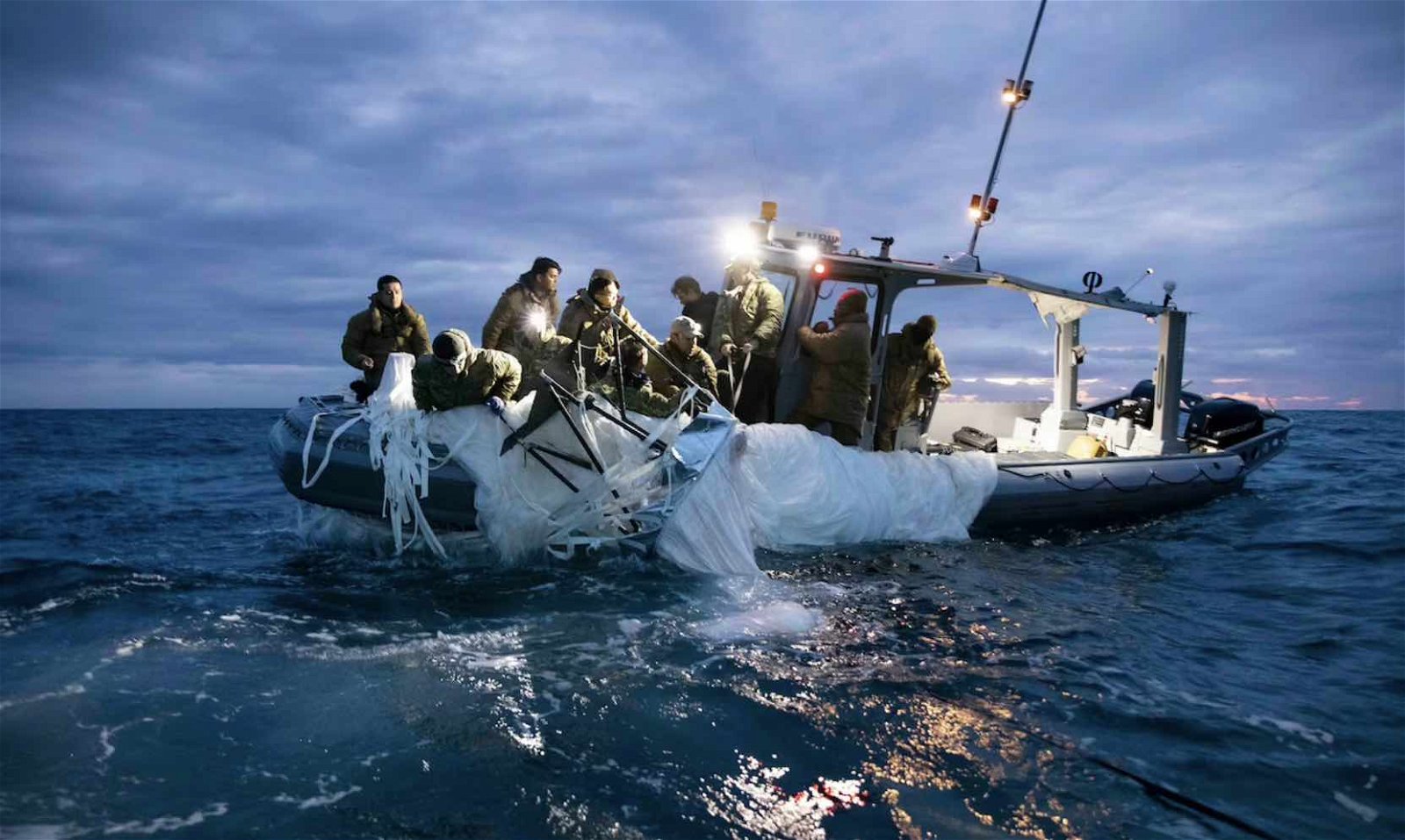

Welcome to this week’s installment of The Intelligence Brief… as U.S. officials continue efforts to collect debris from a Chinese spy balloon shot down off the coast of the Carolinas last weekend, we are learning more about the aircraft’s capabilities, as well as similar past incidents involving balloon surveillance over the Americas. In our analysis this week, we’ll be looking at 1) the controversy that has been brewing since the end of the spy balloon’s strange journey across the U.S., 2) what we have learned about the technological capabilities of the balloon and its payload, and 3) why the Chinese spy balloon incident has led to increased debate over the Pentagon’s investigations into unidentified aerial phenomena.
Sign up here to have The Intelligence Brief newsletter sent to your inbox each week.
Quote of the Week
“It was my assessment that this balloon did not present a physical military threat to North America… therefore, I could not take immediate action because it was not demonstrating hostile act or hostile intent.”
– Gen. Glen VanHerck, Commander, NORAD and United States Northern Command
Latest Stories: Before we get into our analysis this week, a few stories we’re covering at The Debrief include the discovery of a new earth-sized exoplanet orbiting within its star’s habitable zone, and how the Pentagon is secretly developing a new program to unleash thousands of autonomous drones to dominate enemy defenses. We’ll have links to all our recent stories at the end of this newsletter.
Video News: This Friday, also be sure to join Chrissy Newton for the premiere of her discussion with former fighter pilot Ryan Graves on Rebelliously Curious, where they discuss the challenges aviators face in terms of UAP, and how they can be mitigated. Check out past episodes and other great content from The Debrief on our official YouTube Channel.
Podcasts: This week in podcasts from The Debrief, MJ Banias and Stephanie Gerk give us a recap of several of the week’s top stories on The Debrief Weekly Report. Elsewhere, join me for a lengthy analysis of the recent Chinese spy balloon controversy on The Micah Hanks Program, where Space.com Editor Brett Tingley and I discuss the recent incident’s relationship to the Pentagon’s UAP investigations. You can subscribe to all our podcasts, including audio editions of Rebelliously Curious, on our Podcasts Page.
And with all that out of the way, let’s shift our attention over to the latest developments involving the Chinese spy balloon that invaded U.S. airspace in recent days, and what we’ve learned about it.
Controversy Ensues as the Chinese Spy Balloon Ends its Strange Journey
Last Saturday, the strange journey of a Chinese spy balloon first spotted over Montana on its way across the United States ended over the Atlantic, as the craft and its large technological payload were shot down over South Carolina’s coastal waters.
Speaking with the media on Wednesday, Pentagon Press Secretary Air Force Brig. Gen. Pat Ryder said efforts to recover debris from the downed balloon were still underway.
“USNORTHCOM continues their recovery operations in support of the recent takedown of the Chinese high-altitude surveillance balloon,” Ryder said during the press conference.
Led from aboard the USS Carter Hall, efforts to collect debris from the balloon included work by diver teams, as well as underwater drones assisting in the detection of wreckage from the aircraft ad


“As of today, recovery operations of the balloon and the payload continue without issue,” Ryder said Wednesday. “Sea states Tuesday permitted divers and explosives ordnance technicians to conduct underwater salvage and recovery, and underwater survey activities continue using unmanned underwater vehicles.”
Ryder added that “US Coast Guard cutters continue to provide security, and the FBI and NCIS agents continue their work cataloguing debris and transporting it for further processing,” advising the public that any suspected debris should not be handled, and reported immediately to law enforcement.
Although the journey of the spy balloon that resulted in a diplomatic crisis has ended, the controversy is just getting underway, as the assessment of the spy balloon’s capabilities is now underway, and Pentagon officials are opening up about several similar incidents in recent years—some of them logged amidst ongoing sightings of unidentified aerial phenomena being investigated by the U.S. government—which point to a much broader surveillance effort by China than has been previously reported.
So what have we learned about the spy balloon’s technological capabilities since the U.S. brought it down over the weekend?
Spy Technologies in the Belly of a Balloon
With an estimated length of three school buses, assessments about the gear aboard the spy balloon’s dangling payload had already been made by prior to the dramatic shootdown on Saturday. Flybys with U-2s were able to obtain imagery and other intelligence as the airship made its way over the Americas; a fitting use of U.S. planes that once represented the epitome of Cold War-era spy craft.
Once the balloon was shot down by a USAF F-22 Raptor on Saturday, debris was quickly gathered and additional capabilities that included its ability to collect communications signals were revealed early on Thursday. U.S. officials said the devices appeared to be “capable of collecting and geo-locating communications” and that the payload’s solar panels were capable of powering “multiple active intelligence collection sensors.” The U.S. State Department has also said that the debris recovered after Saturday’s shootdown has been associated with a Chinese company with “direct commercial ties” to the Chinese military, according to The New York Times.
Ironically, some of China’s own claims about the balloon and its capabilities at the time they denied its use in espionage pointed to these realities. Attributing the supposed meteorological balloon’s presence over the U.S. to “Westerlies” that carried it off course, the Chinese government paradoxically noted the airship’s “limited self-steering capability,” plainly (though perhaps unintentionally) admitting to capabilities it possessed which appeared consistent with the balloon’s extended lingering over Montana, home to Malmstrom AFB.


In a briefing on Monday, Gen. Glen VanHerck, Commander of North American Aerospace Defense Command and U.S. Northern Command, said the spy balloon’s passage offered “a potential opportunity for us to collect intel where we had gaps on prior balloons,” noting that “this gave us the opportunity to assess what they were actually doing, what kind of capabilities existed on the balloon, what kind of transmission capabilities existed.”
However, it has been revealed in recent days that the great Chinese spy balloon scare of 2023 is just one of several similar incidents that have occurred in recent years, as the significance of past instances involving similar technologies is only now being fully realized.
Sightings of Unidentified Aerial Espionage
Back in June 2020, an odd story was trending on Japanese Twitter, involving the appearance of a large, mysterious white object that had been spotted and photographed over northern Japan near the city of Sendai.
Photos obtained of the unidentified flying object soon revealed it to be a large, white balloon with a cross-shaped dangling payload resembling the solar panels on a communications satellite fitted with spinning propellers. According to statements from officials at the Sendai Weather Bureau cited by Reuters, the object “appeared near dawn and hung in the sky for hours, largely unmoving,” until clouds finally obscured the object. By the end of the day, speculations about the odd aerial visitor on Japanese social media were running rampant and included everything from North Korean propaganda and coronavirus conspiracies to UFOs and even Godzilla.
A spokesman with the Sendai Weather Bureau speaking on background noted of the incident that they had “absolutely no idea what it is,” adding that the object “may be some kind of weather monitoring equipment, but it definitely isn’t ours.”
Fast forward to February 2023, where in recent days an almost identical object detected in its transit across the United States by U.S. officials was subsequently alleged by Chinese officials to also be an errant meteorological balloon.
Admittedly, that was one hell of an attempt at bluffing on China’s part, considering that prior to making news last week, Pentagon officials had already been aware of the balloon and were tracking it, and had briefed President Biden on its presence. China also had to have known that the object and its capabilities would be assessed by U.S. intelligence agencies and, ultimately, the aircraft would likely be shot down and recovered for further evaluation, revealing that it was anything but a mere weather balloon.
Despite these realities, China has yet to back down on its claims. To date, the country’s only public response regarding the incident—one that led to the cancellation of a trip to the country by U.S. Secretary of State Antony Blinken and gave rise to a full-blown diplomatic crisis—were the accusations it leveled against the U.S. following the shoot down on Saturday, calling it an “attack on a Chinese civilian unmanned airship by military force” which it said was “about to leave the United States airspace.”


However, in recent days, the spy balloon saga has now led to a renewed focus on the Pentagon’s investigations of unidentified aerial phenomena, with several U.S. government sources appearing to confirm that data collected on the phenomenon in recent years included what officials now recognize as similar spy balloon incidents.
Several earlier spy balloon incursions “were initially classified as ‘unidentified aerial phenomena,’ according to a recent New York Times article which reported that the incidents “were handed over to a Pentagon task force charged with investigating U.F.O.s and other aerial phenomena.”
This shouldn’t be surprising, since the recent 2022 ODNI report on unidentified aerial phenomena already characterized 163 incidents as involving balloons or balloon-like objects. However, it may be premature to assume that the majority of the incidents being investigated by the DOD involve similar things: currently, 171 incidents being evaluated by the All-domain Anomaly Resolution Office (AARO) still remain unexplained, according to the 2022 ODNI report.
While several incidents AARO is investigating point to the likelihood of surveillance by an adversary nation, the objects involved in at least some of those incidents also appear to represent advanced technologies far beyond the capabilities of the spy balloon Americans were able to watch as it drifted overhead last week, sources familiar with a classified version of the report recently told The New York Times.
During Wednesday’s press briefing, Pat Ryder confirmed that the U.S. is “aware that there have been four previous balloons that have gone over U.S. territory,” and that in some cases “these balloons previously had not been identified,” adding that “subsequent analysis, subsequent intelligence analysis did enable us to indicate that these were Chinese balloons.”
Based on Ryder’s statements, perhaps one of the most important takeaways from everything we’ve watched unfold over the last week is that China doesn’t really need any significantly advanced technologies to confuse the U.S.’s defense and detection capabilities: it seems that for many years, simple balloons were able to succeed in that effort with an unsettling degree of efficiency. Going forward, let’s hope the Pentagon will be better equipped to meet the demands of combatting such deceptively simple strategies enacted by U.S. adversaries.
That concludes this week’s installment of The Intelligence Brief. You can read past editions of The Intelligence Brief at our website, or if you found this installment online, don’t forget to subscribe and get future email editions from us here. Also, if you have a tip or other information you’d like to send along directly to me, you can email me at micah [@] thedebrief [dot] org, or Tweet at me @MicahHanks.


Here are the top stories we’re covering right now…
- Why Does My Dog Howl? It’s Probably Just Their Inner Wolf If your dog doesn’t howl, it may lack the DNA needed to “speak wolf”
New research indicates that if your dog tends to howl in response to other dogs, sirens, or miscellaneous noises, it is likely because your furry little friend is much closer genetically to being a wolf than dogs that don’t howl.
- Science Is Better Than Politics and Popularity Contests
The elemental composition of the first interstellar meteor will be decided by a mass spectrometer, not by the number of likes it gets on Twitter.
- Incursion: Spy Balloons, UAP, and the New Cold War
This week on The Micah Hanks Program, we dive into the Chinese spy balloon controversy and examine one of the most unusual diplomatic crises in recent memory.
- “Impossible” Physics Breakthrough Achieved By Researchers Studying Mysterious “Ghost Particles”
Researchers say they have uncovered a new method of studying protons involving beams of mysterious “ghost particles.”
- Potentially Habitable Exoplanet Found in Our Cosmic Backyard
An earth-sized exoplanet that is orbiting within its star’s habitable zone has been spotted a mere 31 light years away from Earth, offering astronomers and astrobiologists a tantalizingly close new target in the search for extraterrestrial life.
- China Calls U.S. Shoot-Down of Spy Balloon “Indiscriminate Use of Force.” International Law Says Otherwise.
China’s outrage in response to the U.S. shoot-down of a suspected spy balloon falls limp in light of the facts.
- Do Dodo Birds Taste Like Chicken? This week on The Debrief Weekly Report…
In this episode, Stephanie explains how to survive a nuclear blast and how her massive stash of bottle caps will keep her alive in the post-apocalyptic hell world, and MJ finally confesses that he has a culinary passion for Dodo birds.
- Pentagon Secretly Working To Unleash Massive Swarms of Autonomous Multi-Domain Drones to Dominate Enemy Defenses
The Pentagon is secretly developing a new program to unleash thousands of autonomous drones to dominate enemy defenses.
- Breakout Tech: Here Are Some of the Key Developments and Technologies to Watch in 2023
Investor and former television news anchor Clayton Morris examines several of the key developments and technologies to watch in 2023.
- Has Earth Ever Had Encounters With Interstellar AI Devices in Its Past?
What is the chance that a technological gadget with an interstellar version of ChatGPT would visit Los Alamos for lunch in 1950?
- ChatGPT: Does This Clever Chatbot Mark the Dawn of a New Era in AI?
This week, we look at OpenAI’s impressive chatbot ChatGPT, and what it told The Debrief in a series of candid responses to our questions.
- Unexpected Discovery Seemingly Defies Long-Held Experimental Law of Physics, Research Team Claims
A discovery involving variance in friction at different speeds between two different kinds of surfaces seemingly defies an experimental law of physics, according to newly published research.